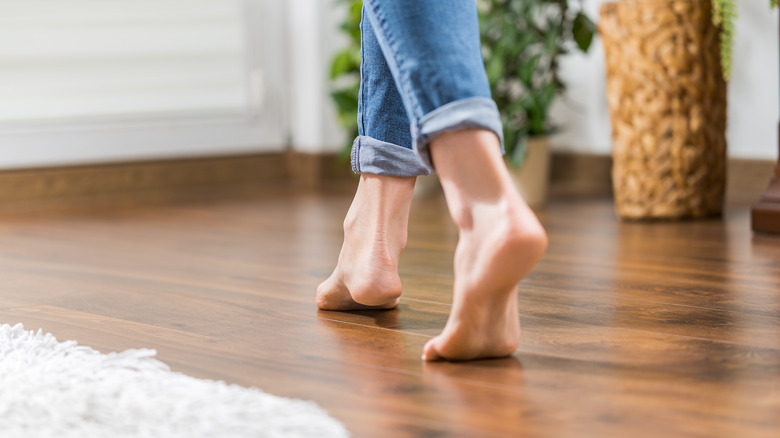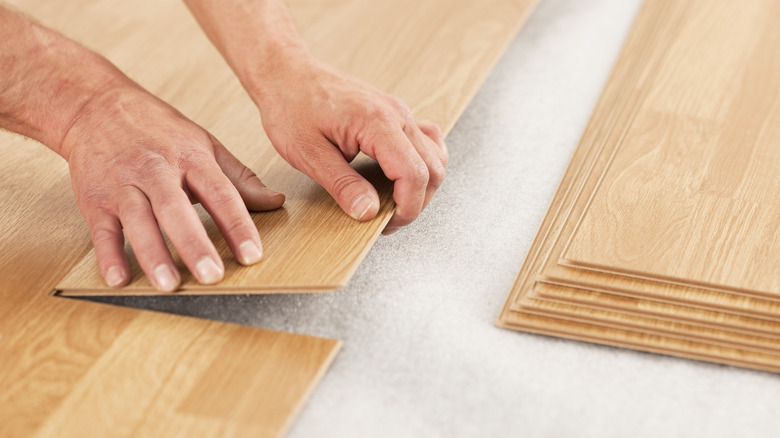Fix Up Your Squeaky Hardwood Floors With This Common Household Item
Squeaky hardwood floors can be a real pain in the neck. Who wants to hear that annoying creaking sound every time they descend their stairs? It's a constant reminder that your floors are not as sturdy as they should be. Not to mention, it can be embarrassing when you have guests stay over and you have to tiptoe around to avoid waking up the whole house. For the average home dweller, knowing how to fix squeaky hardwood floors probably feels out of your wheelhouse of skills. While a squeaky hardwood floor is probably a sign of a lingering issue, there are a few short-term solutions that will at the very least mitigate the creaking sound. One of the easiest solutions to help fix your squeaky floors is lubricating the floorboards.
Lubricating hardwood floors can help eliminate the squeaking sound by reducing friction between the floorboards. When wood expands and contracts with changes in temperature and humidity, it causes the floorboards to rub together, resulting in squeaking sounds. Applying a lubricant, such as WD-40 or silicone spray, to the affected areas allows the floorboards to glide smoothly against each other, reducing friction and eliminating squeaking. While lubricating the creaking floorboards will resolve your squeaking issue temporarily, you should also address the larger issue at hand to determine what it really means when your floors squeak. Consulting a professional is recommended, especially if there may be problems that require more immediate attention.
How to lubricate your hardwood floors to eliminate squeaking
WD-40 is one easy solution for lubricating squeaky hardwood floors. Before applying any lubricant, make sure to clean the floorboards thoroughly to remove any dirt or debris that may be contributing to the squeaking. Shake the can of WD-40 well to ensure that the lubricant is properly mixed, and then spray a small amount of WD-40 directly onto the squeaky areas of the hardwood floor. Be careful not to overspray or saturate the wood. Use a clean cloth or paper towel to wipe off any excess WD-40 from the floor. This will prevent the floor from becoming slippery and reduce the risk of residue buildup. WD-40 is widely available both online and in hardware stores and typically costs under $10 for an 11-ounce can.
In addition to WD-40, silicone spray can also be used to lubricate squeaky floors. The application process for silicone spray is similar to that of WD-40. Begin by cleaning the floorboards then shake the can of silicone spray well to ensure proper mixing. Spray a small amount of silicone spray onto the squeaky areas of the floor. Use a clean cloth or paper towel to wipe off any excess silicone spray. Silicone sprays are a cheaper alternative to WD-40 and come in a variety of brands and sizes. Depending on your choice, silicone sprays can run a few dollars cheaper than WD-40 and provide the same effect.
The more serious issues that may be lurking
Squeaking floors may also indicate a structural issue. One common reason for squeaky hardwood floors is the natural movement of the wood, resulting in squeaking sounds. To address this issue, check that the hardwood floor is properly installed. This includes using the correct type of subfloor, allowing for proper acclimation of the wood before installation, and using the appropriate fasteners to secure the floorboards. Additionally, maintaining a consistent indoor climate by controlling temperature and humidity levels can minimize the movement of the wood and reduce squeaking.
Inadequate subfloor support can cause the floorboards to flex and create squeaking sounds. To resolve this issue, a long-term solution would involve reinforcing the subfloor. This may require adding additional support beams or joists to provide better stability and prevent the floorboards from moving and squeaking. It is important to consult with a professional to assess the subfloor and determine the appropriate reinforcement method.
Finally, squeaky hardwood floors can also be caused by loose floorboards. Over time, the nails or screws that secure the floorboards to the subfloor may become loose, allowing the boards to move and produce squeaking sounds. To fix this issue, re-secure loose floorboards by either replacing the nails or screws with longer ones or using specialized flooring screws designed to eliminate squeaks. Lowe's offers a set of 50 Squeeeeek No More nails for $14.98 which could be just the trick to fix your fussy floorboards.

